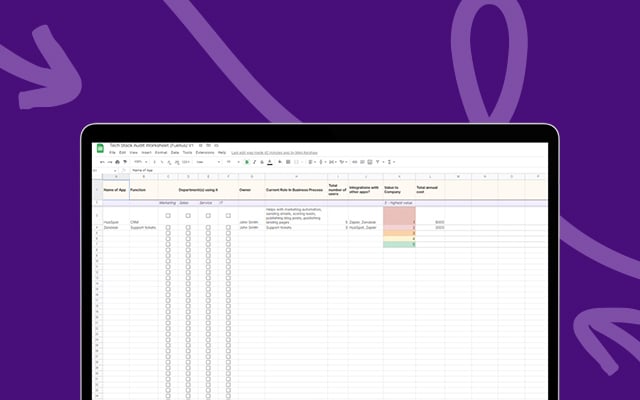
Making Sense of Your Tech Stack: Organising Your Tools for Better Results
Businesses around the world are faced with mounting financial pressures. Though we might have narrowly missed an official recession, we’re not out of the woods yet.
Understandably, businesses need to reassess their current strategy and find ways to cut costs.
Technology budgets feel like a fairer and more rational priority to review ahead of layoffs.
> How to navigate marketing in a recession <
Over the last few years, we’ve been in a somewhat gluttonous state. Thousands of new software solutions and apps have emerged, offering to solve problems you didn’t even know you had.
Now maybe it’s time to take a step back and assess: do you really need it all?
- Tech Stack Meaning: In a couple of sentences
- Assess: What tools are actively used?
- Understand: The impact of tools on processes
- Clear out: Get rid of unused tools
- Consider: What do you really need from new tools
- Audit: Documenting the process
Before we start…
Tech Stack Meaning: In a couple of sentences
In software programming, the tech stack is a term used to describe the tools used to run an app or project, like the coding languages, database and framework.
Regarding business processes, the tech stack we’re talking about is the platforms and software used to run their operations. This can include accounting tools, HR software, website platforms, integrations, SaaS apps and more.
A martech stack is another term specifically used to describe the tools used in the marketing function of a business.
A well-designed tech stack can have a significant impact on the efficiency and effectiveness of your work processes. A cluttered tech stack, on the other hand, can lead to confusion, inefficiencies, and delays in delivering projects.
Having a clear understanding of your tech stack can help you:
- Improve collaboration between teams by ensuring everyone is using the same tools and technologies.
- Streamline work processes by using tools that integrate well with each other, reducing the need for manual processes and reducing the risk of errors.
- Stay up-to-date with the latest technology developments by regularly reviewing and updating your tech stack.
- Improve your workflow by using tools that are well-suited to your specific needs and work processes.
Assess: What tools are actively used?
Before you start evaluating the tools in your tech stack, it’s important to clearly define your goals and objectives. What are you trying to achieve with your technology stack? What are the key challenges you’re facing? Having a clear understanding of your goals and objectives will help you determine which tools are best suited to your needs.
You’ll then want to take stock of all the tools and technologies you’re currently using in your tech stack. Write down the names of each tool and its purpose, and categorise them into groups such as operational function, department, etc. This will give you a clear picture of what you’re using and help you identify any areas that need improvement.
It’s vital that you get stakeholders involved in this process: a singular view of your tech stack will miss key considerations and tools across different departments and teams.
Understand: The impact of tools on processes
Once you’ve taken stock of the tools in your tech stack, it’s time to evaluate their performance.
Ask yourself the following questions:
- Is the tool meeting your needs and expectations?
- Is it easy to use and understand?
- Is it scalable and able to grow with your business?
- Does it integrate well with other tools in your tech stack?
- Is it cost-effective?
If the tool is not meeting your needs or is causing problems, it may be time to consider replacing it with a better-suited technology.
When evaluating the tools in your tech stack, it’s important to consider the impact of any changes you make. Will replacing a tool have a major impact on your work processes and systems? Are there any risks associated with making a change?
Clear out: Get rid of unused tools
The next step is to remove all tools that aren’t actively contributing to your business processes or goals. Again, you’ll need to make sure you’ve clearly documented the tools you recommend removing and alerting all relevant users.
Ideally, organising and auditing your tech stack will help identify tools that you can consolidate to streamline workflows and internal processes.
Many software platforms are now evolving to offer much more than just one solution, usually with lower subscription or purchase costs than selecting multiple vendors. Plus, having your tech stack consolidated means everything is more aligned to one centralised source.
Consider: What do you really need from new tools
When choosing new technologies for your tech stack, it's important to consider several key factors. These include:
Integration with Other Tools: The ability to integrate with other tools in your tech stack is crucial. This will ensure that you can work smoothly and efficiently, without having to constantly switch between different tools.
Scalability: Choose technologies that are scalable and can grow with your business. This will ensure that you can continue to use the tools as your business grows, without having to constantly switch to new technologies.
Ease of Use: It's important to choose tools that are easy to use and understand so that everyone on your team can be productive from day one.
Cost: Consider the cost of the tools you're choosing. While it may be tempting to choose the cheapest option, it's important to remember that you get what you pay for. In some cases, it may be worth paying a little extra for a tool that is more feature-rich and easier to use.
Audit: Documenting the process
Having a well-planned and organised tech stack is key to driving business success and improving your workflow. By keeping these tips in mind, you can create a tech stack that is tailored to your specific needs and work processes, and that will help you achieve better results.
A tech stack audit template can be a valuable tool for assessing and organising your technology stack. It provides a structured framework for evaluating your current tools, identifying areas for improvement, and making informed decisions about future tool choices.
We’ve used our experience carrying out audits for clients to create a tech stack audit template.
Download it now to gain a better understanding of your technology stack, evaluate the performance of each tool, and assess the impact of any changes you make.

Tech Stack Audit Worksheet
A tech stack audit is essential to refresh and realign your toolkit to help save employees time, save money on apps, consolidate apps and maintain a single source of truth for data. Download our free template to get started!



